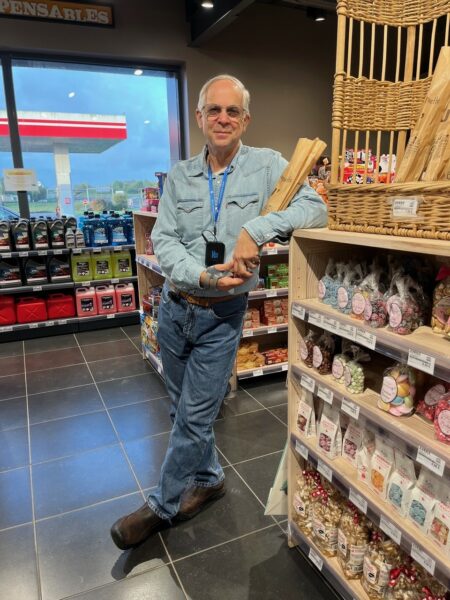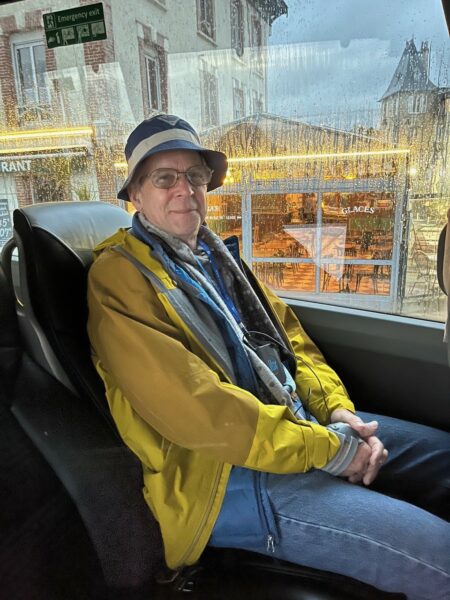Growing up in a family with a history of hearing loss, Jerry was not prepared for the impact hearing loss would have on his life. When he began missing out on vital family bonding time later in life, he knew he needed to find a solution. After receiving a cochlear implant and a hearing aid as a bimodal solution, Jerry is now experiencing word recognition scores of 95% and enjoying all his family conversations! His story below:
“I grew up in a family of hearing loss. Every paternal male member of my family that I can recall had low-frequency bilateral sensorineural hearing loss and used hearing aids. I should have been prepared for what was to come, but when I took my first professional job in my late 20s, I was still shocked when I found that I couldn’t understand conversations over the phone.
I’ve been wearing hearing aids of progressively greater power for the past 40 years. I always managed to get by pretty well. I had a great career as a geologist and retired as an acting director at a research organization in 2017.
Fast forward to 2021, and my wife (Sherri) and I have just adopted an adult daughter (Iby) from Panama (we have no children of our own). We had been a host family for two girls for 6 years while they were attending a local college on scholarship. One of the two returned to Panama as the COVID pandemic struck, and Iby stayed to work on a master’s degree at our local university. My wife and I had always talked about offering a ‘symbolic’ adoption because of Iby’s less than desirable family situation at home. We learned about the process in Kentucky and began our petition to the court.
 A leap of faith – a bimodal hearing solution
A leap of faith – a bimodal hearing solution
Suddenly we had a daughter (including her fiancée) – we spent much time at the dinner table becoming a family during COVID. That’s when it hit me that I was missing most of this once in a lifetime experience. I knew that I was at the end of the road with hearing aids and the advice from audiologists to explore cochlear implantation was my only hope. After a couple of meetings with my audiologist, I took a leap of faith and scheduled my surgery.
The only decision I had to make was which surgery site to use. I chose a small practice 45 miles from our town over the local university because I could have my surgery sooner. Both sites used Cochlear technology. My implantation was in April 2022 and activation was in June of that year. My progress has been nothing but amazing.
I chose to purchase a new ReSound ONE™ hearing aid for my opposite ear, because of its ability to synchronize with the Cochlear devices. I also chose to receive the off-the-ear, Cochlear™ Nucleus® Kanso® 2 Sound Processor as well as the behind-the-ear alternative: Nucleus 7 Sound Processor.
I’m a very active individual and find that I need the greater security of the Nucleus 7 Sound Processor when I’m working outdoors or cycling. The Kanso 2 Sound Processor is my preferred sound processor for most of the day.
I needed to visit my audiologist one month after activation to pick up my new hearing aid. She decided to retest my hearing levels while I was there. My word recognition on the implant side increased from 0% to 74% in one month! And with the new hearing aid, I improved to 84%. At my one-year anniversary I tested at 95%-word recognition bilaterally.
The impact of a cochlear implant in my life
Both my surgeon and audiologists say this level of improvement and over such a short period is quite unusual. They attribute the outcome to my overall good health, the amount of work I put into the rehabilitation process, especially in the early weeks and my comfort with using assistive technology like streaming1 devices. I also think the Cochlear Sound Processor’s compatibility with the ReSound hearing aid helped blend sounds in my brain to produce clearer speech.
Receiving a cochlear implant has transformed my life in many ways large and small. My wife reminds me of what a change it has made in her life as well. We can have conversations while I’m driving the car without miscommunication. I’ve been going back to the cinema without needing captioning devices. I’m using my phone with complete confidence and no longer have to ask Sherri to take calls for me and most of all, I’m a full participant in family conversations around the dinner table.
 Taking advantage of technology even in uncertainty
Taking advantage of technology even in uncertainty
This year Sherri and I decided to take a guided tour of northern France to celebrate our 40th anniversary, something I probably wouldn’t have considered before implantation. About two weeks prior to departure, I received an email from the tour company advising us that we would be using an audio system extensively throughout the trip. Their system uses a wired 3.5mm jack to connect to earbuds and is not Bluetooth® compatible. My heart sank. I knew that earbuds weren’t an option for me, and headphones weren’t much better. Then I recalled an external streamer I used with previous hearing aids that had a 3.5mm jack for audio input. If only I had one! I sent an email to Mallory, a Cochlear Engagement Manager, asking if she had any streaming options for this situation. She immediately replied that I already had one in the Mini Mic 2+ that was provided at activation.
I use the Mini Mic regularly in restaurants as an external microphone with great success. I had no idea about its other functionality. Sure enough, it has a 3.5mm jack and can receive audio input and just needs to be toggled into that mode. It also can receive input from FM systems used by some theaters.
I took my mic and a short 3.5mm cable and it worked flawlessly through the entire trip, not only with the tour system, but with audio systems provided by many museums. It was a great trip and listening experience. And I’ve learned my lesson about reading every page of the instruction manual for electronic devices.”
If you are struggling with bilateral hearing loss, learn how a bimodal hearing solution may be able to help you experience a richer, and more natural experience.1
2 3References:
- Ching TY, Psarros C, Hill M, Dillon H, Incerti P. Should children who use cochlear implants wear hearing aids in the opposite ear?. Ear and hearing. 2001 Oct 1;22(5):365-80.
- For a full list of smartphone and app compatible devices, visit: www.cochlear.com/compatibility and www.resound.com/compatibility.
- ReSound is a trademark of GN Hearing A/S
- The Bluetooth® word mark and logos are registered trademarks owned by Bluetooth SIG, Inc. and any use of such marks by Cochlear is under license.